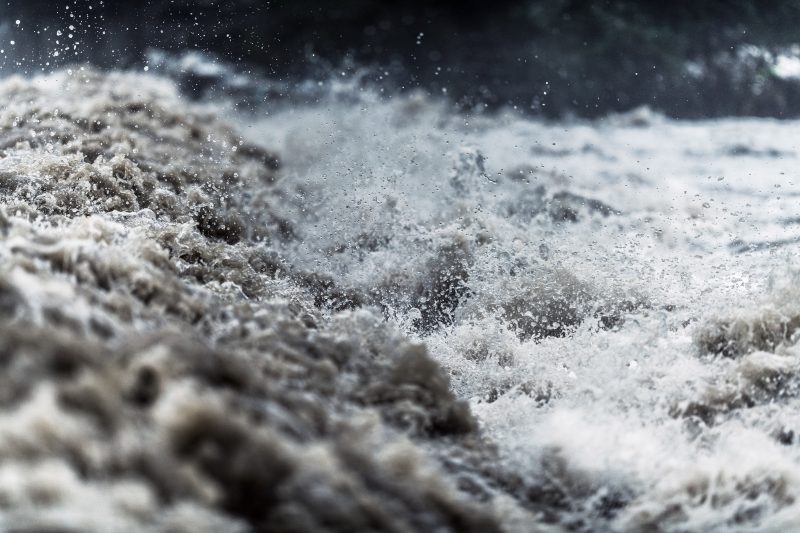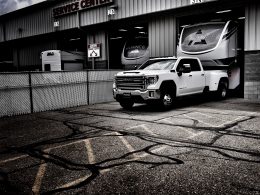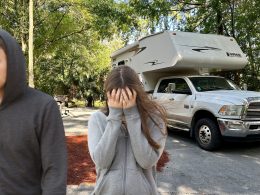Are You Ready for a Flash Flood in Your RV?
Beautiful campsites along the water’s edge are always the most desirable. But these same sites could be the first to disappear if a flash flood invades the campground. Even those regions miles away from a tranquil lake or rippling river can fall prey to sudden heavy rainfall, leaving RVers stranded at their campsites or abandoning their rigs altogether. Do you know what to do if you’re caught in a flash flood while camping?

Flash Floods Can Happen to Anyone
The name says it all. “Flash floods” can occur in a flash! Without a little bit of preventative planning, anyone can end up a victim when heavy rains fall in a matter of minutes. We don’t have the power to stop the rain, but there are ways we can be ready for an emergency if it does occur.
Even RV Campgrounds Are Susceptible to Flash Floods
Campgrounds aren’t immune to flash floods. Many seek out those river and lakeside campsites. But one good microburst may send campers scurrying away from fast-rising floodwaters.
As referenced in the video above, even communities close to a dam can suffer from high water. Know the landscape around your campground and check out the weather forecast. If rain has been falling before your arrival and it continues, that beautiful lake might turn into a nightmare with little warning.
Are You Ready for a Flash Flood in Your RV?
Sometimes there’s nothing that you can do to avoid damage caused by flash floods. But you may reduce your discomfort by preparing ahead of time. For instance, many times when floodwaters from a lake first reach a campsite, the campground’s first move will be to turn off electricity to the affected sites. Make sure you have fuel for your generator, as the waters may recede before you even have to move, but the electricity may remain off for some time.
Campsites located under big trees can prove troublesome when storms include high winds or hail warnings. If safety and time allow, move your rig to a less compromised site.
How to Be Prepared for a Flash Flood
Although we can’t change the weather, we can plan for emergencies. Here are a few suggestions regarding preparedness before flooding occurs.
Avoid Campsites Near Water During Rainy Seasons
Familiarize yourself with common weather patterns at your destination. If it’s monsoon season in the desert, don’t plan on camping next to a wash. Likewise, if it has been raining for a while before you arrive at a river’s edge campsite, consider moving uphill, away from the water. It’s surprising just how fast stormwater can rise and how dangerous it can be.

Always Check the Weather
Start by knowing what county your campsite is in. Keep abreast of changes in the weather with phone apps or a weather radio. It might be worth investing in an emergency crank radio rather than depending on electricity or battery power for other devices. Talk to camp hosts or campground managers about where to find the best local weather stations for information. And if storms roll in late at night, stay on the alert.
Have a Go-Bag
Put your necessities in one bag by the door. Include things like your billfold and personal documents, keys, a flashlight, your phone and tablet, a dog leash, and anything you couldn’t live without for a day. That way, if you must evacuate quickly, you won’t spend time trying to scramble to pack items you don’t want to leave behind.
Be Prepared to Evacuate, With or Without Your RV
Sometimes a split second is all you have to decide whether to stay or go. And at that moment, you may have to leave your RV behind. Depending on the situation, you may only be able to take your tow vehicle or just yourself away from the campsite in a hurry. Think about what decisions you might have to make before an emergency happens.
Always Have an Exit Plan
When you roll into a campground, spend some time exploring the landscape around you, looking for quick exit strategies and shelters. Also, look at options for moving on down the road, should the weather turn on you. Where can you head quickly if the current campsite is no longer usable? What will you need to pack up so that your escape is quick and easy? It might be a good idea to store outdoor items before the weather gets too bad.

Flash Flood Safety Tips
Here are a few dos and don’ts when encountering flooded campgrounds.
Stay Away from Flooded Areas
Don’t venture into floodwaters for any reason, either by foot or in a vehicle. The power of moving water can be deceptive, so move away from water as much as is possible.
Do Not Swim or Play in Flood Waters
The kids might think high water is a great excuse to wade or play, but those waters could be extremely dangerous. Walking into a flooded area can quickly turn scary, as you may not know just how deep the waters are. Currents in the water can carry not only human beings but vehicles and structures away in the blink of an eye. And animals may be in the water, like snakes and gators. Downed powerlines could also pose a threat if they touch the water.
Never Attempt to Drive Through Flooded Roads or Areas
Even if floodwaters are stagnant, vehicles can stall out. There’s no way of knowing if roads or infrastructure got damaged underneath the water, either. And finally, moving water has a power that can overwhelm quickly, taking a car, truck, or RV along with it. Don’t take the chance and end up stranded in floodwaters. Whenever possible, move back from waters rather than driving through them.
Don’t let a flash flood take you completely by surprise. Make a plan long before you ever encounter this dangerous scenario, and you’ll know how to keep yourself and your rig safe. Have you ever witnessed a flash flood? What did you do?
If You Want the Latest Travel News, Join Our Mailing List
Don’t rely on biased RV industry news sources to keep you informed. Stick with Nomadic News. We publish articles and breaking stories that matter to you every weekday.










